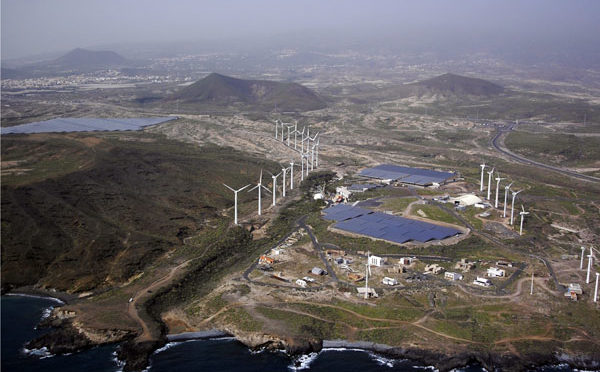Wind energy installed in the Canary Islands has grown by 137.11% in the last three years, reaching 390 megawatts, amount equivalent to the annual consumption of 343,615 households, which represents 43% of the 801,779 homes in the Canary Islands.
These are some of the data that the Minister of Economy, Industry, Trade and Knowledge, Pedro Ortega, put on the table at the meeting he had with the wind farm developers of the Canary Islands to analyze the implementation of wind energy on the islands, and which also attended the Deputy Minister of Industry, Commerce and Knowledge, Gonzalo Piernavieja.
At the same time, he referred to the intensive work that has been done in recent years to streamline the administrative processing and investments required both the construction of new wind farms and the adequacy of the wind turbines facilities of the Canarian electrical system to ensure that take full advantage of the new energy that is generated.
“We have made a great effort, both by the Government of the Canary Islands and by the promoters and the system operator, so that the new facilities are in operation before the end of 2018,” said the counselor.
In this line, he appreciates that it has been possible to go from the 53 wind farms that were in 2015 to count, in 2018, with 34 more wind power plants that are in operation and another 13 that are in the process of being built.
This advance has resulted in an increase in clean energy installed in the islands, which, he added, “by the end of this year will double compared to 2015, from 330MW to 660 MW, which will involve a share of the 20% of electricity produced from renewable sources “.
In parallel, the capacity of the transport network has been expanded with the construction of new substations and their respective evacuation lines in Gran Canaria, Tenerife, Lanzarote and Fuerteventura.
In addition, two extensions have been carried out for the evacuation of renewable energy.
As a result of these advances, it has been possible to double the number of wind farms in Lanzarote and increase its installed wind power by 167%.
Something similar has happened in Gran Canaria and Tenerife, whose power has been increased by 90 and 65% respectively.
Pedro Ortega also assured that “the immediate future implies to continue advancing in more renewable energies thanks to the two new specific quotas that will go out for the islands and that will allow approaching 45% of penetration of renewable energies in 2025”.
With regard to this objective, he added that wind energy will continue to have a significant weight in the clean energy sector, especially offshore wind, where the islands have become the only Spanish region that has a marine wind turbine on its coasts.
“The installation of this prototype drives the strategy of the Canary Islands Government to develop an offshore wind area of ??around 140 square kilometers for the installation of wind turbines in the pre-commercial phase and companies wishing to install offshore wind farms,” ??he added.
The meeting was attended by representatives of eleven companies and institutions responsible for wind farms in the Canary Islands, including COAC, EOATLÁNTICO, SL, Pérez Reyes Group, DISA Group, Alas Capital, Renovertis, Gas Natural Fenosa, Iberdrola, Lanzarote Water Consortium, Ecoener and the Institute of Renewable Energies (ITER).
During the meeting, Pedro Ortega reported that, according to the forecasts of the Ministry of Energy, in mid-December the second specific quota of wind power for the Canary Islands will be approved by this legislature.
“This is a very important step for the energy future of the islands,” said the counselor who recalled that, according to the commitment reached with the State, during the first half of 2019 a third specific quota of renewables will be published for the islands, both wind and photovoltaic.
With regard to the balance of the last three years, Pedro Ortega said that “the Canary Islands have gone from living 10 years of blockade to be at the head of the Spanish regions where the implantation of this type of clean energies has increased the most”.
In this context, he highlighted as decisive the steps that the Government of the Canary Islands took at the beginning of the Legislature and with which it succeeded in getting the State to withdraw its appeal against the Canary Islands Decree regulating the wind farms on the islands, and agreed to draw, in December 2015, a specific remuneration regime for a total of 49 wind power plants, with a total capacity of 436.3 MW.



